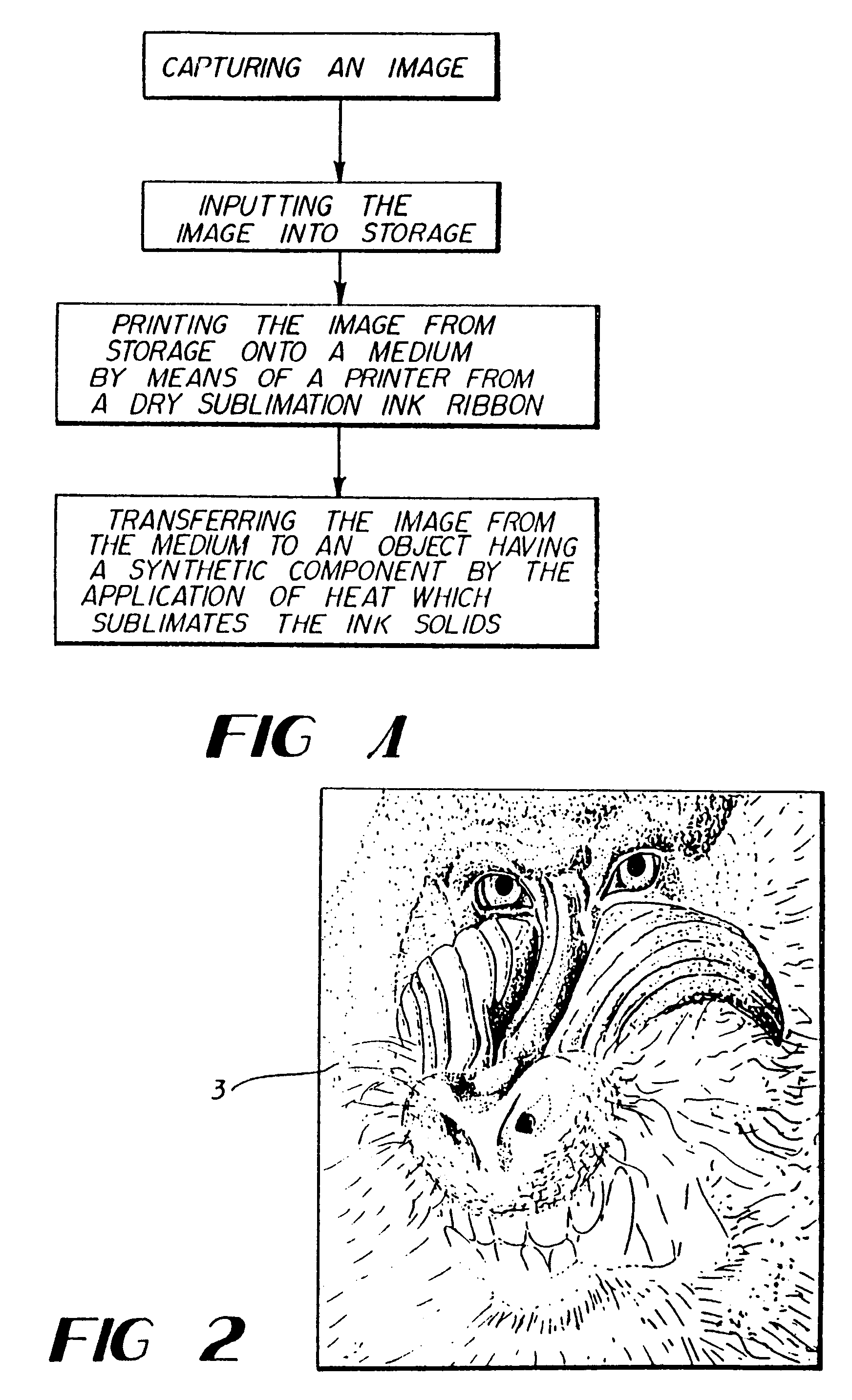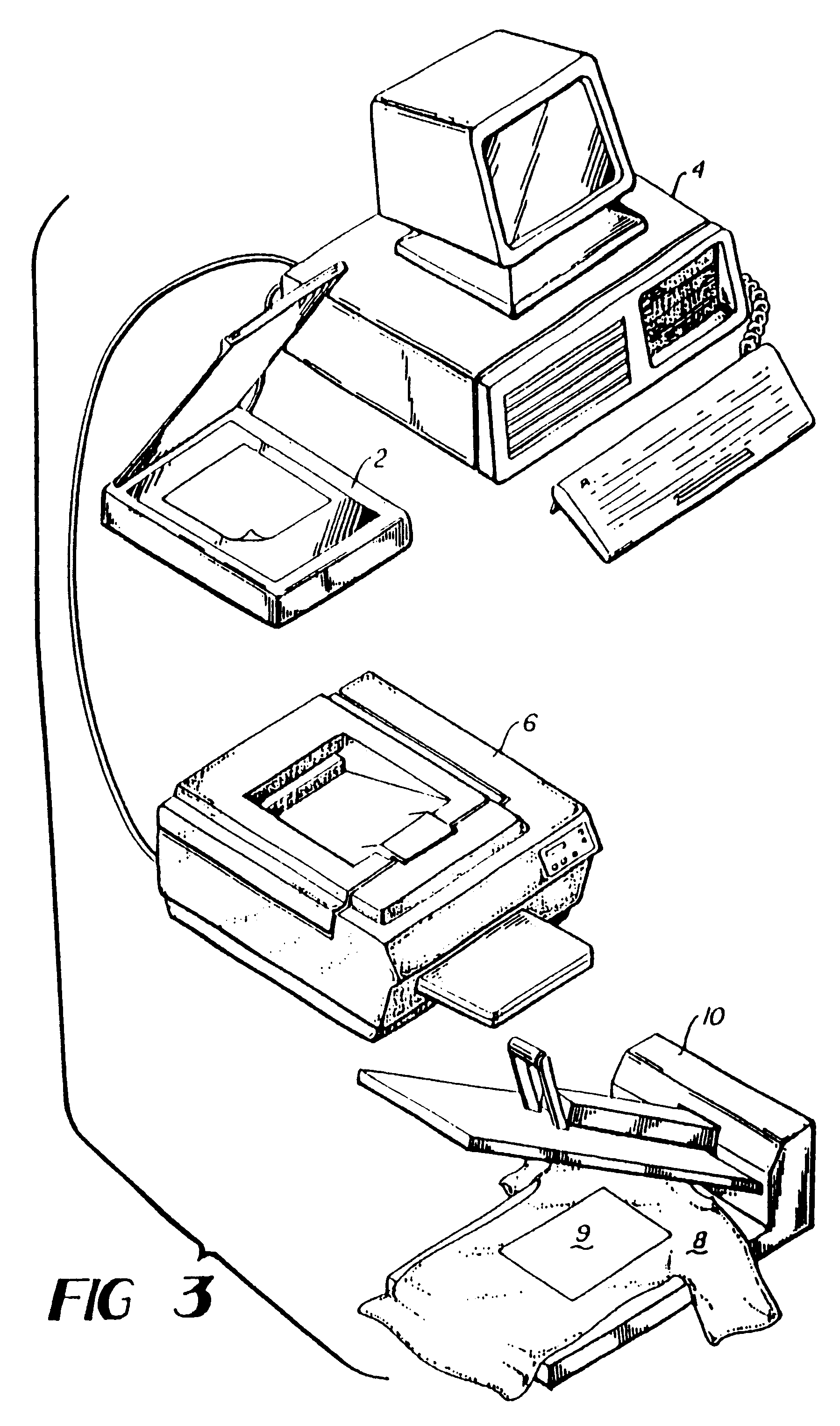Permanent heat activated printing process
a technology of permanent heat activation and printing process, which is applied in the direction of electrographic process, transfer printing, instruments, etc., can solve the problems of dull colors and inability to meet the requirements of most applications, and achieve the effect of increasing the solubility of ink
- Summary
- Abstract
- Description
- Claims
- Application Information
AI Technical Summary
Benefits of technology
Problems solved by technology
Method used
Image
Examples
formulation example 2
comprises a heat activated yellow ink solid or dye. Dipropylene glycol and DMSO are co-solvents. Sodium Hydroxide is an inorganic emulsifying enforcing agent, which also acts as a fungicide. Distilled water acts as a solvent. Cobratec.RTM. acts as a corrosion inhibitor.
In this formulation, a particular ink solid is finely divided to yield a small particle size. The particular ink solid of Example 2 will tend to substantially dissolve within sodium hydroxide, which is used as the emulsifying enforcing agent. The combination of the sodium hydroxide and the solvent, which is the formulation example is distilled water, yield an emulsion which may be used in bubble jet and free flow ink jet printers.
Generically, a "humectant" is a moisturizing agent. In the relevant art, the term "humectant" is used to describe agents which are included in ink formulations to regulate the rate at which the ink dries and to control the viscosity of the ink. In addition to these properties, the present inv...
formulation example # 3
FORMULATION EXAMPLE #3
Cyan Ink-Jet Formula:
Sublaprint.RTM. Blue 70013 is a heat activated ink or dye solid. Lignosol.RTM. FTA and ME.RTM. 39235 are emulsifying enforcing agents. Lignosol.RTM. FTA also acts as a fungicide. ME.RTM. 39235 is a polymer, and more specifically, it is a polyethylene binder. Diethylene Glycol and DMSO act as humectants. The solvent is distilled water.
Sublaprint.RTM. Blue 70013 is more difficult to sublimate than Bifaxan.RTM. Yellow 3GE, and is less soluble in the emulsifying enforcing agent. Diethylene glycol is used as a humectant to facilitate sublimation of the Sublaprint.RTM. Blue ink solid.
The heat activated ink solid is finely divided to a small particle size. The finely divided ink solid is combined with one or more emulsifying enforcing agents, which are in turn combined with the solvent.
FORMULATION EXAMPLE #4
Magenta Ink-Jet Ink Formula:
Formulation Example #4 comprises a heat activated ink solid or dye which is finely divided and combined in an emul...
formulation example # 4
Formulation Example #4 further comprises an anti-foaming or foaming control agent, DeeFo.RTM. 806-102 to retard foaming of the liquid ink composition. Formulation Example #4 further comprises a surfactant, which may be Sorbitol.RTM., and a corrosion inhibitor, which, in this example, is NA-SUL.RTM..
Formulation Examples 2, 3 and 4 are emulsions. In Example 2, the particular dye has a tendency to dissolve in the emulsifying enforcing agent. Formulation Examples 3 and 4 may also be described as colloids, having finely divided ink particles of not larger than 0.1 microns in diameter present within the disperse medium.
The invention provides an emulsion or colloid which will work within free flow ink jet printers, piezo electric printers, and bubble jet printers, without experiencing problems relating to orifice clogging which results from the use of an ink solid. Further, the use of an emulsion or colloid prevents the separation of the ink solids from the liquid components, rendering an ...
PUM
| Property | Measurement | Unit |
|---|---|---|
| diameter | aaaaa | aaaaa |
| temperature | aaaaa | aaaaa |
| temperature | aaaaa | aaaaa |
Abstract
Description
Claims
Application Information
 Login to View More
Login to View More - R&D
- Intellectual Property
- Life Sciences
- Materials
- Tech Scout
- Unparalleled Data Quality
- Higher Quality Content
- 60% Fewer Hallucinations
Browse by: Latest US Patents, China's latest patents, Technical Efficacy Thesaurus, Application Domain, Technology Topic, Popular Technical Reports.
© 2025 PatSnap. All rights reserved.Legal|Privacy policy|Modern Slavery Act Transparency Statement|Sitemap|About US| Contact US: help@patsnap.com



